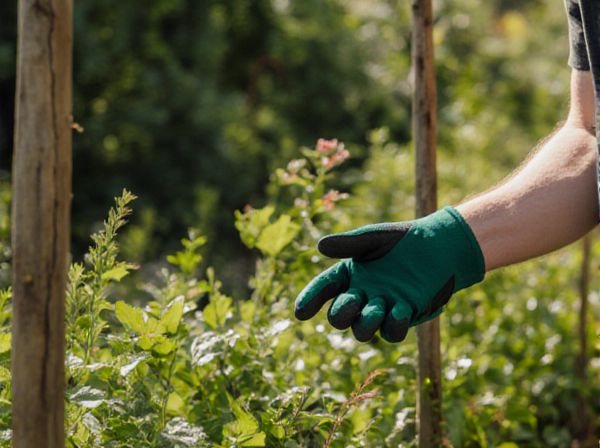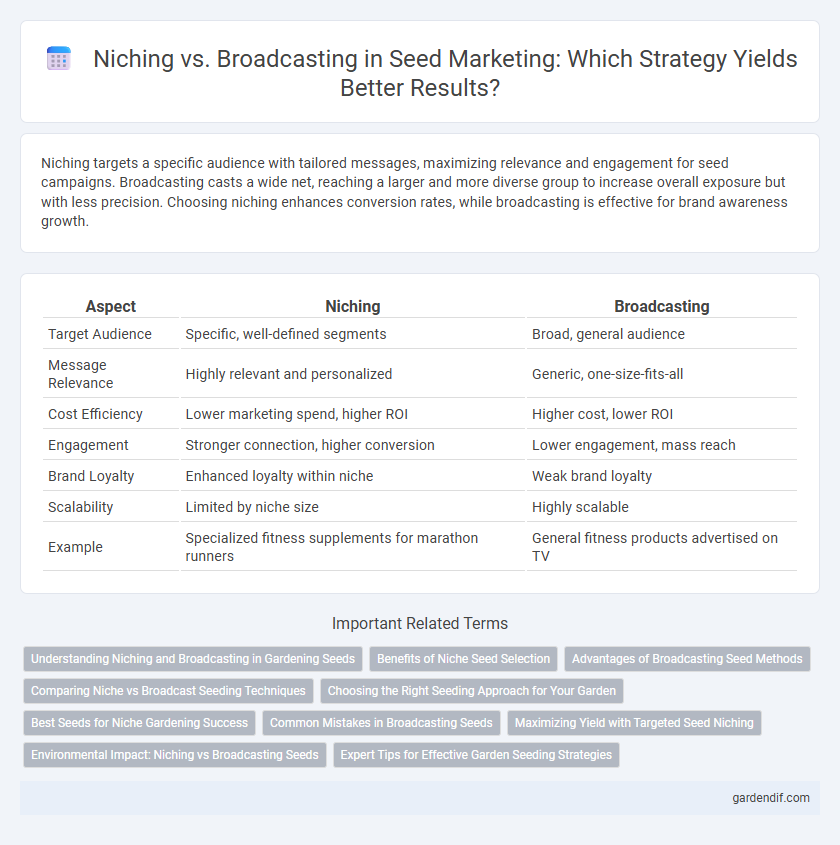
Niching vs Broadcasting Illustration
Niching targets a specific audience with tailored messages, maximizing relevance and engagement for seed campaigns. Broadcasting casts a wide net, reaching a larger and more diverse group to increase overall exposure but with less precision. Choosing niching enhances conversion rates, while broadcasting is effective for brand awareness growth.
Table of Comparison
| Aspect | Niching | Broadcasting |
|---|---|---|
| Target Audience | Specific, well-defined segments | Broad, general audience |
| Message Relevance | Highly relevant and personalized | Generic, one-size-fits-all |
| Cost Efficiency | Lower marketing spend, higher ROI | Higher cost, lower ROI |
| Engagement | Stronger connection, higher conversion | Lower engagement, mass reach |
| Brand Loyalty | Enhanced loyalty within niche | Weak brand loyalty |
| Scalability | Limited by niche size | Highly scalable |
| Example | Specialized fitness supplements for marathon runners | General fitness products advertised on TV |
Understanding Niching and Broadcasting in Gardening Seeds
Niching in gardening seeds involves selecting specific plant varieties tailored to targeted growing conditions, optimizing yield and disease resistance. Broadcasting seeds means scattering them broadly across a garden area, promoting widespread coverage but with less precision in seed placement. Understanding the differences helps gardeners enhance plant success by aligning seed choice with their environmental needs and gardening goals.
Benefits of Niche Seed Selection
Niche seed selection improves crop efficiency by targeting specific environmental conditions and soil types, leading to higher germination rates and healthier plant development. This focused approach reduces competition from weeds and pests, optimizing resource use and increasing yield quality. Farmers benefit from reduced input costs and enhanced sustainability by selecting seeds adapted to localized climates and ecosystems.
Advantages of Broadcasting Seed Methods
Broadcasting seed methods offer the advantage of reaching a broad and diverse audience, increasing the likelihood of widespread engagement and rapid information dissemination. This approach maximizes coverage and brand visibility, making it ideal for campaigns aiming to generate buzz or build mass awareness quickly. Broadcasting also allows for scalable data collection and feedback, which can optimize future marketing strategies.
Comparing Niche vs Broadcast Seeding Techniques
Niche seeding targets specific, well-defined audience segments, maximizing engagement by tailoring content to their precise interests and increasing conversion rates through focused messaging. Broadcast seeding distributes content widely across diverse platforms and demographics, aiming for broad reach and brand awareness but often resulting in lower engagement per individual. Comparing niche vs broadcast seeding highlights the trade-off between targeted relevance and expansive exposure, where niche seeding drives higher quality interactions and broadcast seeding generates larger volume impressions.
Choosing the Right Seeding Approach for Your Garden
Choosing the right seeding approach is crucial for a thriving garden, where niching focuses on planting specific seed varieties tailored to unique soil and climate conditions for optimized growth. Broadcasting spreads seeds broadly across the garden area, suitable for ground cover or wildflower gardens, promoting natural dispersion and less intensive care. Understanding soil type, plant species, and garden goals guides whether targeted niching or broad seeding maximizes germination and garden health.
Best Seeds for Niche Gardening Success
Selecting the best seeds for niche gardening success involves focusing on specialized varieties that thrive in specific microclimates and soil conditions. Heirloom and rare seed varieties, such as specialty herbs, heritage vegetables, and native wildflowers, offer higher adaptability and unique genetic traits that boost growth and yield in targeted environments. Prioritizing seeds with proven compatibility to local ecological niches enhances plant health, reduces competition, and maximizes garden productivity.
Common Mistakes in Broadcasting Seeds
Broadcasting seeds often leads to uneven seed distribution and poor seed-to-soil contact, which reduces germination rates and crop uniformity. Over-seeding is a frequent mistake, causing resource competition among seedlings and increasing susceptibility to diseases. Failure to calibrate broadcasting equipment results in inconsistent application rates, wasting seeds and lowering overall yield potential.
Maximizing Yield with Targeted Seed Niching
Maximizing yield with targeted seed niching involves selecting specific seed varieties optimized for particular soil types, climates, and farming practices to enhance growth efficiency and crop performance. Focused niche targeting reduces resource waste and increases germination success rates compared to broad broadcasting methods that scatter seeds indiscriminately. Precision seed placement improves plant density and health, resulting in higher agricultural productivity and sustainable farming outcomes.
Environmental Impact: Niching vs Broadcasting Seeds
Niching seeds into specific microhabitats reduces environmental impact by promoting biodiversity and minimizing resource waste, allowing plants to thrive in optimal conditions. Broadcasting seeds can lead to uneven resource distribution, increased competition, and potential habitat disruption, often lowering overall germination success. Targeted seeding strategies enhance ecosystem stability by supporting native species and reducing the need for additional interventions like watering or fertilization.
Expert Tips for Effective Garden Seeding Strategies
Choosing a niching strategy in garden seeding focuses on selecting specific plant varieties suited to precise soil and climate conditions, maximizing growth efficiency. Broadcasting seeding disperses seeds broadly, improving ground coverage but requiring careful timing and soil preparation to reduce competition and enhance germination rates. Expert tips emphasize analyzing soil pH, moisture levels, and seed density to optimize seed placement for higher yield and disease resistance.
Niching vs Broadcasting Infographic

 gardendif.com
gardendif.com